 |
All About Asparagus - Cooking Tips |
| view article online: https://www.recipetips.com/kitchen-tips/t--817/all-about-asparagus.asp |
Tools for Preparing and Cooking Asparagus | Preparing AsparagusCooking Asparagus | Asparagus Tips AsparagusAn asparagus recipe can be simple and uncomplicated but still be full of flavor, or it may be combined with other ingredients to create a recipe of mingled flavors.There are many methods that can be used for cooking asparagus spears. Cooking asparagus can be accomplished by methods as simple as boiling to grilling for a great charred flavor. Whatever cooking method or asparagus recipe you use, you are sure to enjoy the garden fresh flavor of asparagus. To learn more about asparagus preparation and asparagus cooking, see the information below. 
A vegetable with long, tender shoots that are generally categorized as white, purple and green varieties, all belonging to a plant in the lily family. The shoots of the green or white variety are usually harvested when the stalks reach a height of 8 inches and are 1/4 to 1/2 inch thick. They are always harvested by hand. The color of the asparagus is determined by the amount of exposure to sunlight. This vegetable has small leaves that look like scales tightly packed near the tips, which are especially popular because of their soft to crunchy texture and mild flavor. Green asparagus is traditionally the most common variety in the United States, while purple or white asparagus is usually available on a limited basis in specialty markets. White asparagus is the type that is most popular in Northern Europe. The white variety has less flavor then the green or purple. The purple variety is generally harvested when the stalks reach a height of approximately 3 inches. Once cooked, this asparagus provides a somewhat distinctive fruity flavor. Uses:Asparagus can be boiled, steamed, sautéed, grilled, pickled, or served cold. It makes an enjoyable appetizer, or a good complement to salads, vegetable dishes, and soups. Asparagus can also be pureed to be used for soups and soufflés. At Their Best:Asparagus is best when in season in your area, which in many areas begins in March and runs through June. Asparagus is harvested throughout the year in one area of the world or another, making it available year round. It is best when eaten within a couple of days of harvesting so if it needs to be brought in from another area of the world the quality is not going to be as good as it would be if purchased locally. When it is in season in your area and you can purchase it the same day or within a day or two of harvesting. How to Buy:Select asparagus with stalks that are firm, crisp, and have heads that are full, tightly closed, and not discolored. Check the aroma from the bunched asparagus as it should not give off an objectionable odor. The ends of the asparagus that have been cut should be moist and fresh in appearance, not dried or cracking. Storage:Asparagus is very perishable. Fresh asparagus will last about 3 to 4 days while blanched asparagus can last for 9 months in the freezer. Do not wash asparagus before storing. Wash it just before using. To store fresh asparagus, wrap the stalks in a damp cloth and place in a plastic bag that is not airtight. Airtight bags will trap moisture, causing the asparagus to become soggy. Fresh asparagus can also be stored by trimming an inch off the stem end, wrapping ends with a wet paper towel and then stand the spears upright in a glass or upright container filled with a couple of inches of water. Place a loose plastic bag over the spear tips and store in the refrigerator. Varieties:
Purple Asparagus Green asparagus is grown in a flat bed so that it is exposed to the sunlight. Exposure to the sunlight increases the chlorophyll content, which is what makes the asparagus green. The stalks are harvested when they are approximately 8 inches tall and 1/4 to 1/2 inch thick. Green asparagus has a more intense nutty flavor than the white or purple asparagus. 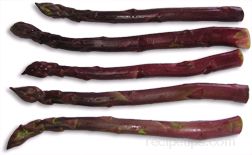
Green Asparagus Purple asparagus is grown in mounds similar to the white asparagus except it is allowed to grow approximately 3 inches above the surface before it is harvested. During this time it is exposed to the sunlight just enough to begin changing colors. When exposed to the sun the asparagus first turns light purple, then purple, and finally green. The purple variety is harvested before it turns green. Its flavor is slightly more intense than the white asparagus. 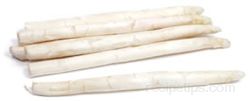
White Asparagus White asparagus is grown underneath a mound of dirt that keeps the stalks from turning green. Once the stalks crack through the surface of the mounds they are harvested. The white asparagus is harvested in the early morning so that it has limited exposure to the sun. Too much exposure will start to turn the asparagus green. White asparagus has a more delicate flavor than green or purple asparagus. Tools for Preparing and Cooking AsparagusThere are not a lot of tools necessary when you are working with asparagus but there are a few special tools that can assist in preparation and cooking. Some of these tools are shown below. 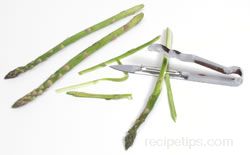
Asparagus Peeler On thicker asparagus where the outer skin is tough, this special tool can be used to cut and peel the tough layer of outer skin away from the tender meat within the stalk. It contains a peeling blade that comes in contact with the asparagus as the upper arm of this utensil is pressed against the stalk. The asparagus is then manually pulled through and against the peeling blade. The upper arm easily adjusts with pressure to the diameter of the asparagus. This tool can also be used to peel other similar vegetable. A regular vegetable peeler can also be use to peel the tough skin away from the asparagus. 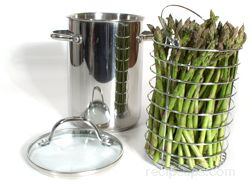
Asparagus Steamer An asparagus steamer is a type of cookware specially designed for preparing asparagus. The steamer consists of a long and narrow wire basket, a steaming pot, and a lid. The wire basket holds a large quantity of asparagus upright. The upright position allows the hard, thicker stems to cook in approximately 2 inches of boiling water while the tips of the asparagus gently steam. Water is placed in the bottom of the steaming pot and brought to a boil. The asparagus stalks are arranged in the wire basket (spears upward) and lowered into the boiling water. When the spears become just tender, the basket is removed and the water is drained away. 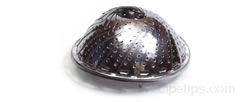
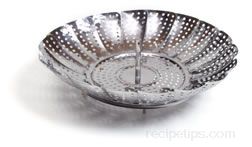
Collapsible Steamer Basket A collapsible basket can also be used to hold the asparagus over boiling water so that they can be steam cooked. The asparagus can be placed in the basket whole or it can be cut into 1 to 2 inch pieces and then placed in the basket. This type of basket will adjust to the size of the pan. Also called a "steamer insert." 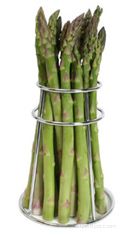
Asparagus Cooking Rack (Asparagus Cooker Stand) This stainless steel rack is built to hold the asparagus so it can be cooked vertically with the stems standing in several inches of water when cooking. The Asparagus Cooking Rack provides an alternative way to steam asparagus if an asparagus steamer, consisting of a tall narrow circular pot with a steaming basket inside, is not available. The rack can be used when boiling or steaming asparagus. Since the height of the cooking rack is approximately 6 inches and the height of the asparagus will add several more inches overall, you will need a fairly deep pot to cook in. If you do not have a pot deep enough where you can cover the pot with a lid, you can use aluminum foil to cover it while cooking. It is also referred to as an asparagus cooker stand. Preparing AsparagusRinse asparagus under cold running water to remove any dirt or sand from the stalks and tips before beginning preparation. Do not wash until ready to use. Store the asparagus unwashed. 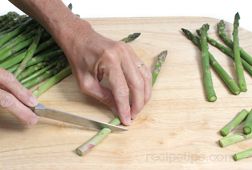
Begin preparing the asparagus by simply trimming off the bottom ends of the stalks. Find the area where the green color begins to fade. This is where the tough woody end begins and is where the stalk should be trimmed off. Do not remove the spears at the top of the stalk. 
An alternative method is to snap off the asparagus ends. Hold an asparagus spear firmly towards the end and bend it until it breaks naturally. The spear should break at the point where it becomes tough. 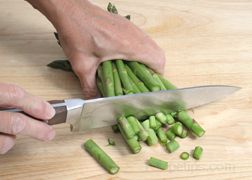
After removing the ends, the stalks will be varying lengths. Keep this in mind when considering your presentation. If it is important that the spears be the same length, line them up flush at the top and trim them off at the bottom so that they are all the same length. If appearance is not critical, do not trim to even lengths because this ends up wasting some of the good asparagus spear. 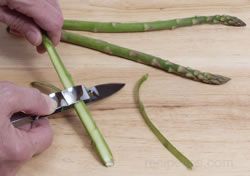
To prepare spears that are thick and have tough skin, cut off the ends as shown above and peel the skin with an asparagus peeler. 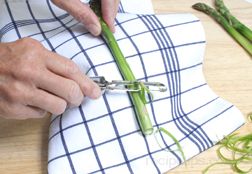
A regular vegetable peeler can also be used to peel the stalks. Do not peel the tips. Younger, thinner asparagus generally are tender enough that they do not require peeling. White asparagus have a tougher stem and should always be peeled. 
Some recipes may call for "cut" asparagus. The spears should be cut at a diagonal in 1 and 2 inch pieces, depending on what the recipe calls for. Several spears can be cut at one time. Cutting the spears into pieces will expose the most flesh and help to ensure even cooking, which may be critical for some recipes. Cooking AsparagusSteaming Asparagus | Boiling Asparagus | Sautéing AsparagusRoasting Asparagus | Grilling Asparagus | Microwaving Asparagus There are many cooking methods that can be used to cook asparagus. There are some commonly used methods shown below. The cooking time may vary from the times stated below depending on the freshness and size of the asparagus you are cooking. Be careful that you do not overcook the asparagus. Overcooking will deplete the flavor and the texture of the asparagus will become mushy. Steaming AsparagusSteaming is the most common cooking method used to cook asparagus. It cooks the asparagus spears gently and brings out its natural flavor. Steaming Whole Spears Upright Prepare the asparagus for steaming upright by tying the asparagus into bundles for easier handling. This allows you to stand the asparagus up while steaming to ensure even cooking. The dense asparagus bottoms will be exposed to more intense heat if steamed while standing and this will ensure that they will be done cooking without overcooking the more fragile tips. 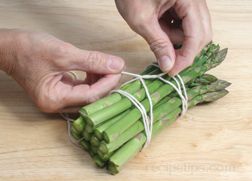
Cut a piece of kitchen string long enough to wrap around the bundle a couple of times. Wrap the bundle of asparagus towards the top and then again towards the bottom. Tie the string into a knot or bow to secure it. 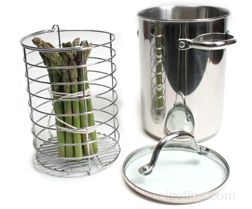
If you have an asparagus steamer, place the bundle into the wire basket of the steamer unit. When using this type of basket you do not have to tie the asparagus into a bundle to cook the spears vertically because the basket will hold them up but when tied, they are easier to handle through out the cooking process. If you do not have an asparagus steamer, use a deep pot to steam the bundle. You can use potatoes in the bottom of the pot, placed around the bundle, to help keep the asparagus upright. 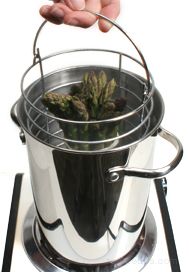
Add approximately 1 1/2 to 2 inches of water into the bottom of the asparagus steamer pot and bring to a boil. Once the water is boiling, place the basket into the steamer pot. Cover the pot while steaming. Turn down the heat to medium-low so that the water is at a slow boil. 
The asparagus should be cooked for 2 to 6 minutes, just to a crisp tender. Begin checking doneness after 2 minutes. To check for doneness, lift the basket from the pot and allow the water to drain away. 
Pull a spear from the center of the bundle to check for tenderness. Poke the spear with a fork or taste test to check doneness. Cooking time will vary depending on the thickness and age of the asparagus. Fresh asparagus requires less cooking. 
When the steamed asparagus spears become bright green and crisp tender they are ready for serving. Season the asparagus with salt and pepper to desired taste. Serve while still warm. A little butter can also be added for extra flavor. Steaming Cut Asparagus To steam asparagus in this manner, first cut the spears into 1 to 2 inch pieces as shown above. 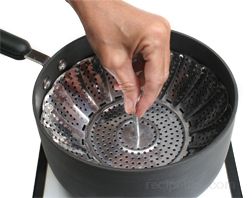
Add enough water to a saucepan so that it is below the bottom of the steamer basket when the basket is placed in the pot. Check to be sure the water does not come up in the basket when placed down in the pan. Bring the water to a full boil using high heat. 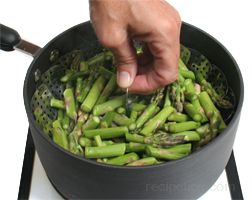
Place asparagus pieces in the steamer basket and place the basket in the saucepan over the boiling water, making sure no water is coming up through the holes in the steamer. Turn the heat down to medium, cover the pan, and cook the asparagus 2 to 8 minutes or until crisp tender. 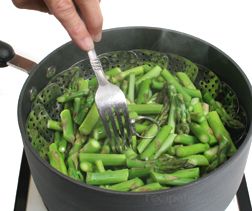
Check the asparagus after 2 minutes to ensure that it does not overcook. The asparagus is done when it is crisp tender. Remove steamer basket from the pot, season, and serve immediately while hot. 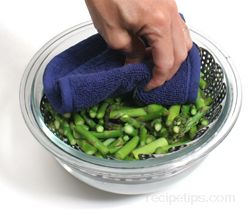
If the asparagus is going to be served cold or added to a cold dish, such as a salad, be sure to submerge them in cold water and then remove them immediately. This will prevent further cooking. Boiling AsparagusWhen using boiling as a method to cook asparagus be very careful not to overcook it. It is easy to cook it too long in the boiling water. If the asparagus is boiled too long it will become mushy and its flavor becomes depleted. The boiling method below shows how to wrap the asparagus in bundles using foil to help prevent the tender tips from being overcooked in the boiling water. 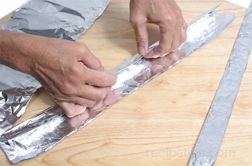
Using 18" wide, heavy-duty aluminum foil, tear off a 6 to 7 inch. Fold the foil pieces in half lengthwise and then continue to fold lengthwise several times until the piece is approximately 1 inch wide. If you are not using heavy-duty foil, you will have to use a little more foil to get enough thickness on the foil to hold the tips out of the water. 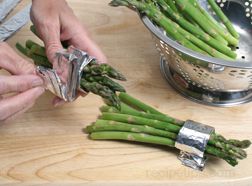
Wrap 6 or 7 spears of asparagus with the foil strips. Wrap the foil around the small bundle twice. Fanfold the remaining length of foil to create folds that are approximately 2 inches wide. 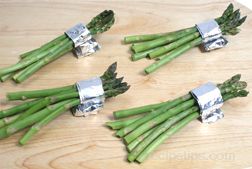
The fanfolded piece of foil will hold the fragile tips of the asparagus out of the water while the stalks are being cooked in the boiling water. 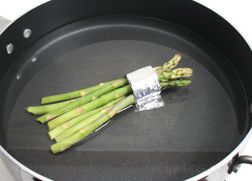
Add enough water to a pan so that the asparagus stalks will be submerged in water. Place one of the bundles in the water to check the level. 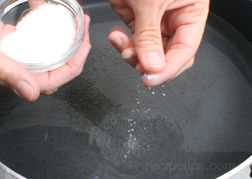
Remove the bundle, add a pinch of salt, a pinch of sugar, and bring the water to a boil. 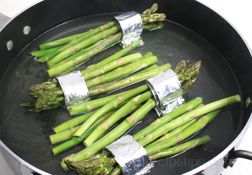
Once the water is boiling, add the bundles of asparagus. Lower the heat and cook for 2 to 3 minutes until the spears become bright green and are crisp tender. 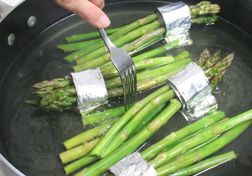
Check tenderness by poking the thicker end with a fork. Cooking time will vary depending on the thickness and age of the asparagus. Do not allow the asparagus to overcook. 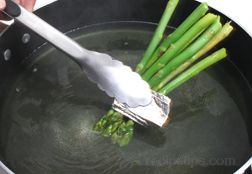
Remove the bundles of asparagus from the boiling water and place in a bowl. Then lift one bundle of asparagus with a tongs and dip the tips into the boiling water for 30 seconds. 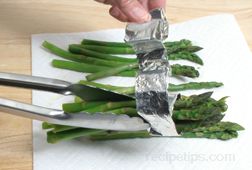
Place that bundle on a double layer of paper towels to allow the excess moisture to drain. Dip the tips of the remaining bundles in the same manner. Once all the tips have been dipped in the boiling water, remove the foil from the bundles. 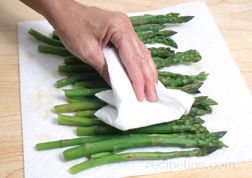
After removing all the foil, pat the asparagus spears dry with a paper towel. 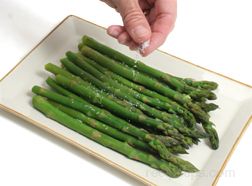
Allow the spears to cool if using in a cold dish, otherwise place them on a serving platter, sprinkle lightly with salt, and serve while still warm. Sautéing AsparagusSautéing is a great method for cooking asparagus. It gives the texture of the asparagus a little crispness and adds extra flavor. 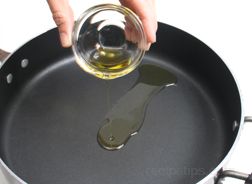
Cut the asparagus diagonally into to 2 inch pieces as shown above. Heat a skillet over medium-high heat, and then add 1 tablespoon olive oil or butter. 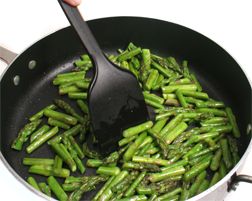
When oil is hot, add asparagus and cook 3 to 5 minutes, stirring constantly until asparagus is crisp tender. 
For extra flavor, sauté the asparagus a little longer until it is more browned and slightly crispy. Season to taste and serve while warm. Roasting AsparagusThe simple method of roasting asparagus lightly browns and cooks the asparagus to give it a unique flavor. 
Preheat the oven to 450 degrees. Clean and trim asparagus stalks as shown above. If the spears are damp, pat dry with a paper towel. 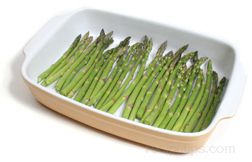
Spread prepared asparagus spears on a large rimmed baking sheet or baking dish. Avoid overcrowding. Use 2 pans if needed. Crowded asparagus tends to steam rather than roast. 
Drizzle asparagus lightly with your choice of olive oil or vegetable oil. Use approximately 2 to 3 tablespoons per bundle of asparagus. Roll asparagus to coat completely. Use just enough oil to lightly coat the entire spear. The asparagus should not be sitting in puddles of oil. 
Sprinkle the asparagus sparingly with sea salt. Kosher or regular salt can be used if you do not have sea salt available. 
Place the asparagus in the preheated oven. Allow the spears to roast for 11 to 17 minutes. Occasionally shake the pan or roll the asparagus to turn it during the cooking time for even browning. Check tenderness after about 10 minutes of cooking time. The asparagus is done when the spears are lightly browned and crisp tender. Grilling AsparagusWhen grilling asparagus, avoid using the spears with thick stalks. The thicker spears tend to burn on the outside before they are cooked to the proper tenderness. If the asparagus is fairly thick, it may be a good idea to blanch the spears before grilling so that the outsides do not burn before the inside of the stalk is done. To blanch, place asparagus into boiling salt water for 1 minute. Remove the asparagus. Submerge asparagus into cold water and remove immediately to prevent further cooking. Pat it dry with a paper towel before applying oil. 
Have the grill heated to a medium heat. Clean the asparagus by rinsing under cold water and the pat dry with a paper towel. 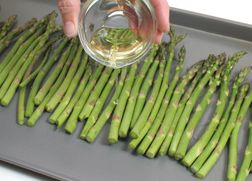
Lay the asparagus out on a plate or cookie sheet and drizzle with 2 to 3 tablespoons of olive oil or vegetable oil. 
Roll the spears back and forth so that the entire stalk is coated. Sprinkle the coated asparagus lightly with salt. 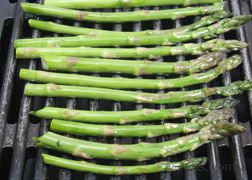
Place the asparagus on the grill so that the stalks are perpendicular to the grates on the grill so that they do not fall through them. Leave a little space between stalks. Note: A grill basket could also be used to hold the asaparagus while grilling. 
Grill the asparagus for 5 or 6 minutes, turning them slightly every few minutes to provide even grilling. 
When done, the asparagus should have delicious caramelized brown spots and a crisp tender texture. The spears should be browned but not charred. It is ready to be served as a side dish or it can be added to other ingredients to create a tasty grilled asparagus recipe. 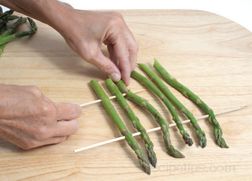
Tip: For easier grilling and visual appeal, skewer 6 or 7 spears crosswise, in two places. Insert the skewers just below the tips and 1 to 2 inches from the bottom. It is best to leave a bit of space between the asparagus stalks. The skewers make it easier when placing on the grill, turning the spears, and removing the asparagus from the grill. If using wooden skewers, be sure to soak them in water before using. Microwaving Asparagus
Clean and trim asparagus stalks as shown above. Place one pound of fresh asparagus into a microwavable safe serving dish. Arrange whole spears with tips towards the center. 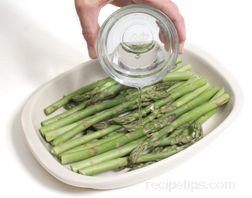
Add 1/4 cup of water and cover tightly with plastic wrap, leaving a small opening for steam to vent. Microwave on high a total of 4 to 8 minutes stirring once. If preparing cut asparagus, microwave on high a total of 3 to 6 minutes, Stir once or twice, depending on how long you need to cook. 
Check for doneness after 3 minutes. Asparagus is done when it is crisp tender. Check tenderness by poking with a fork or by taste testing. Asparagus Tips
|
| Copyright 1999-2025 - Tecstra Systems Corporation/RecipeTips.com - All Rights Reserved |